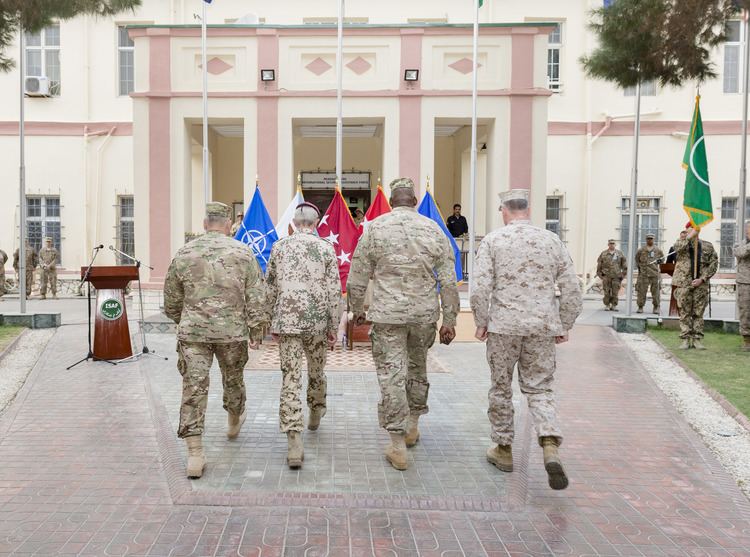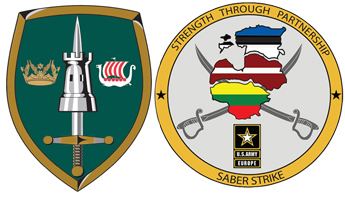Founded 1 July 2004 | ||
Deputy Commander Lieutenant general Fernando Alejandre, Spanish Army Chief of Staff Lieutenant general Janusz Adamczak, Polish Army Motto One Mission (Many Nations) Similar Allied Joint Force Comman, Supreme Headquarters Allied Po, Allied Command Transformation, NATO Response Force, Allied Forces Northern Profiles | ||
Major general jerry martinez usaf headquarters allied joint force command brunssum
The Allied Joint Force Command Brunssum is a NATO command at Brunssum, the Netherlands.
Contents
- Major general jerry martinez usaf headquarters allied joint force command brunssum
- History
- Hendrik van Nassau Ouwerkerk Camp
- Static War Headquarters Castlegate
- Subordinate Commands in 1989
- Commanders
- References
History
Originally the command was known as Headquarters, Allied Forces Central Europe (AFCENT) when it was activated in August 1953 in Fontainebleau, outside Paris, France.

After General Dwight D. Eisenhower was appointed as Supreme Allied Commander Europe (SACEUR) in 1950, he found that devising command arrangements in the Central Region, which contained the bulk of NATO’s forces, was to be complicated. General Eisenhower considered naming an overall Commander-in-Chief (CINC) for the Central Region but soon realized it would be difficult to find an arrangement that would satisfy all three major powers with forces in the Centre - the United States, United Kingdom and France - because their views on the proper relationship of air and ground power differed significantly.
Drawing upon his Second World War experience, Eisenhower decided to retain overall control himself and did not appoint a CINC for the Central Region. Instead there would be three separate commanders-in-chief (for Allied Air Forces Central Europe, Allied Land Forces Central Europe and Flag Officer Central Europe (FLAGCENT), all reporting directly to SACEUR. Vice Admiral Robert Jaujard of the French Navy was appointed as Flag Officer Central Europe, and served from 2 April 51 until 20 August 1953. On 20 August 1953 General Ridgeway, Eisenhower's successor, established a single Commander-in-Chief (CINCENT) for the region with subordinate land, air and naval commanders (COMLANDCENT, COMAIRCENT, and COMNAVCENT respectively).

One of the command's exercises in the 1950s was Operation Counter Punch. Counter Punch was a September 1957 AFCENT air-ground military exercise that also tested NATO's integrated air-defense system in its central European front. The exercise involved the national air-defense systems of Britain, France, Belgium and the Netherlands, with Général d'Armée Jean-Étienne Valluy, French Army, NATO's Commander-in-Chief Allied Forces Central Europe (CINCENT), in overall command. Operation Counter Punch revealed deficiencies in the Integrated NATO Air Defense System as well as air force responsiveness to theoretical Soviet and Warsaw Pact ground advances.

After July 1962 and the establishment of Commander Allied Forces Baltic Approaches (COMBALTAP), German naval forces were shifted into that command. Thereafter there was no longer any need for the small headquarters of Allied Naval Forces Central Europe and its two subordinate commands, and they were disestablished in 1962, leaving naval liaison provided by a US naval officer.

AFCENT remained in France under French command until 1967, when France removed itself from the military command structure. The headquarters was moved to Brunssum in 1967 and activated under German command.
In 2000, the deactivation of Headquarters, Allied Forces Northern Europe (AFNORTH) in Kolsås, Norway led to the redesignation of AFCENT as Regional Headquarters, Allied Forces Northern Europe (RHQ AFNORTH). The headquarters operated as RHQ AFNORTH until 2004, when it was renamed Allied Joint Force Command Brunssum (JFC-B) to add flexibility to the military command structure by removing regional restrictions.
Circa 2010, JFC Brussum appears to be responsible for Contingency Plan Eagle Guardian, NATO's Article 5 plan to defend Poland, Lithuania, Latvia, and Estonia.
Hendrik van Nassau-Ouwerkerk Camp
Hendrik van Nassau-Ouwerkerk Camp is the headquarters and main base area of JFC Brunssum. Other organizations located on Hendrik van Nassau-Ouwerkerk Camp are the NATO Communication and Information Systems Services Agency, Sector Brunssum (NCSA-B) and the NATO Airborne Early Warning & Control Programme Management Agency (NAPMA).
Hendrik van Nassau-Ouwerkerk Camp also boasts an all ranks club called Club 13, a small tax-free department store called the B&S Store, a film theatre, a swimming pool, tennis courts and a gymnasium. Additional services are provided by the AAFES on US Army Garrison Schinnen.
Static War Headquarters Castlegate
Static War Headquarters Castlegate is a NATO command and communications bunker located approximately 2 km north-east of the town of Linnich, Germany. SWHQ Castlegate is operated in caretaker status by a German military contingent.
Subordinate Commands in 1989
During the Cold War, AFCENT commanded the following units:
The III CUS orps was allocated as NORTHAG reserve. On activation, it would have deployed to Europe from bases in the United States. A forward element, 3rd Brigade, US 2nd Armored Division, was located at Garlstedt, Germany. US III Corps also maintained a forward headquarters at Tapijn Kazerne, Maastricht, Netherlands.
Commanders
The commander of JFC-B is known as Commander, Joint Force Command Brunssum. The position was formerly known as Commander-in-Chief North (CINCNORTH) and Commander-in-Chief Central (CINCCENT). JFC-B is normally commanded by a German General but now is commanded by an Italian four-star general for the great contribution of the Italian armed forces to NATO. The current commander is General Salvatore Farina of the Italian Army.
